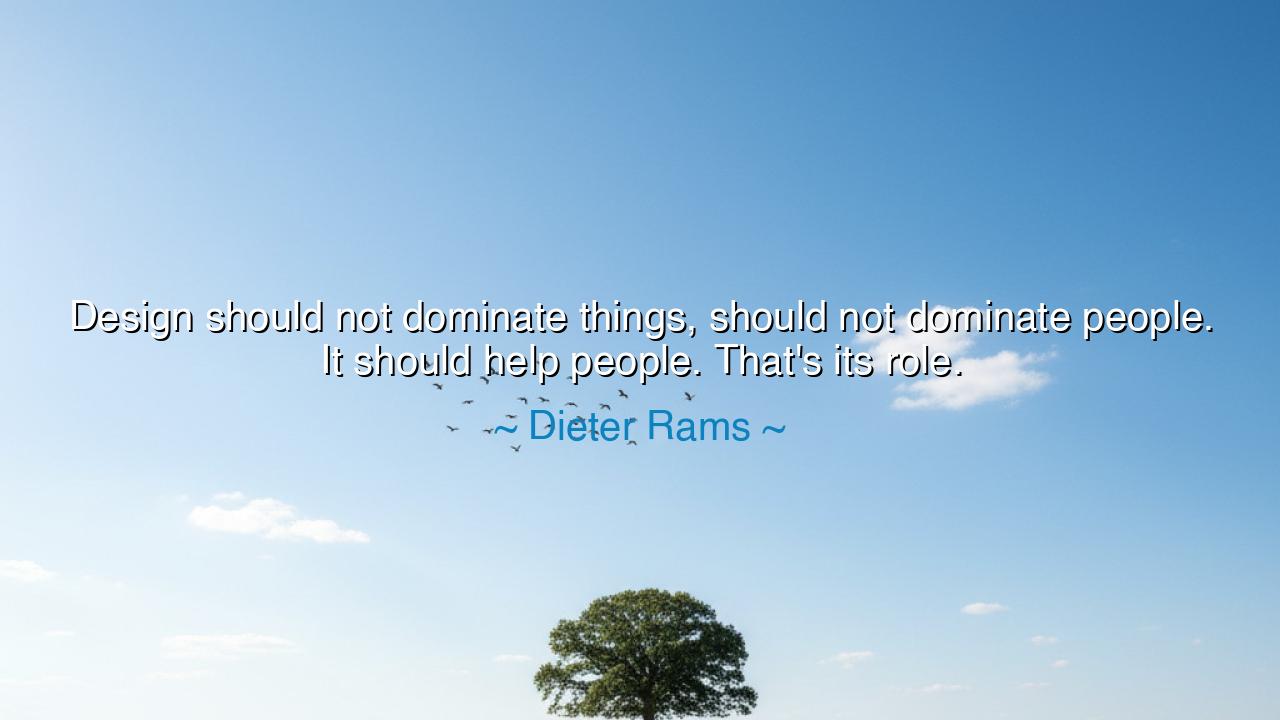
Design should not dominate things, should not dominate people. It
Design should not dominate things, should not dominate people. It should help people. That's its role.






When Dieter Rams declared, “Design should not dominate things, should not dominate people. It should help people. That’s its role,” he spoke not only as a designer of objects, but as a philosopher of living. His words rise like a hymn to humility in an age intoxicated by excess — an age where form often eclipses purpose, and style overshadows substance. Rams reminds us that the highest purpose of design is not to impress, but to serve. True beauty, he tells us, is not loud; it whispers. It does not command attention but offers quiet companionship. In his view, the designer is not a god who imposes his will upon the world, but a steward of harmony, crafting things that uplift life without overwhelming it.
Born in postwar Germany, Rams came of age amid ruins — both physical and moral — when the world was rebuilding itself from the devastation of human arrogance. His design philosophy grew from that history. Working for Braun, he created objects that were as pure as they were functional: radios, clocks, and record players shaped by simplicity, precision, and restraint. They did not demand admiration; they invited use. For Rams, good design was honest, unobtrusive, and enduring. He believed that design must never enslave people to complexity or vanity, but must help them live with clarity and grace. His quote, therefore, is not only about craft, but about ethics — a warning that whenever human creativity serves ego rather than empathy, it loses its soul.
To understand the power of Rams’ message, we must consider what happens when design seeks to dominate. In every age, there have been creations so obsessed with spectacle that they forget their purpose. Consider the extravagant palaces of kings who built monuments to their pride while their people starved, or the modern devices that dazzle with features but frustrate with use. Such things, Rams would say, fail the test of goodness. They serve neither beauty nor humanity, but vanity. For design that seeks domination becomes tyranny — the tyranny of confusion, excess, and noise. True design, by contrast, is like a wise servant: it anticipates needs without intrusion, it empowers without commanding, and it makes life better without demanding gratitude.
Rams’ teaching echoes the wisdom of the ancients, who saw virtue in balance. The Greek philosopher Aristotle spoke of the “golden mean” — the harmony between too much and too little. The same truth applies to design. A chair that dazzles but cannot be sat upon, or a tool so complex that it confuses its user, is not progress but regression. Rams’ philosophy finds kinship with nature itself, where every form follows function. A tree grows not for display, but for life; its beauty is the byproduct of its purpose. Likewise, design reaches its highest form when it serves human need naturally, when it fits into life so seamlessly that we forget it was ever designed at all.
Consider also the modern heirs of Rams’ legacy — most notably, Apple’s Jony Ive, who drew deeply from Rams’ principles in shaping the minimalist world of the iPhone and the Mac. Ive once said that Rams’ designs “did not try to make a statement; they tried to be.” This is the heart of Rams’ philosophy: design as presence, not performance. The quiet dignity of an object that fulfills its role perfectly is more profound than the shout of one that seeks attention. It is a reminder that progress does not mean more, but better — not dominance, but cooperation between man and material.
The deeper meaning of Rams’ words reaches far beyond design. In truth, his quote is a parable about power and humility in every form of creation. Just as design should serve people, so too should leadership, technology, and art. Whatever we build — whether a city, a company, or a work of thought — must serve the human spirit, not enslave it. When creation ceases to help and begins to rule, it betrays its origin. The true creator is not a tyrant but a gardener, cultivating beauty, usefulness, and order in service of life.
So, O seeker of wisdom, take heed of Rams’ teaching: do not create to dominate — create to help. Whether your tools are words, colors, steel, or code, let your work make the world gentler, not harsher; clearer, not louder. Ask always, “Does this help others? Does it make life more human?” For in the end, the worth of all design — and indeed of all action — lies in how well it serves the people who live with it. As the ancients might have said: The finest design is invisible, yet it elevates all who touch it. Let your creations be such — silent servants of goodness, forever helping the world without seeking to rule it.






AAdministratorAdministrator
Welcome, honored guests. Please leave a comment, we will respond soon